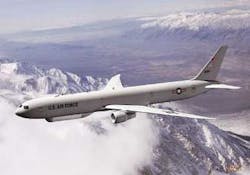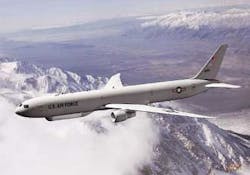Air Force starts work on follow-on surveillance aircraft to Joint STARS
By Ben Ames
WASHINGTON — An early version of the U.S. Air Force Joint Surveillance Target Attack Radar System aircraft — better known as Joint STARS — provided unprecedented real-time targeting data in the first Persian Gulf War of 1991.
Now the service is planning to launch an improved version of the plane, called the E-10A, with production aircraft due in 2011. The new version will combine sensor signals with ground and air radar tracking, and then send real-time data to soldiers and their weapons.
null
Air Force leaders awarded a $215 million contract for weapon system integration, to a team including Northrop Grumman Corp. in Los Angeles, Boeing Co. in Seattle, and Raytheon Co. in Lexington, Mass. The Air Force also awarded $126 million contract to Boeing to purchase a 767-400 ER jetliner to serve as the first test bed.
The original Joint STARS, formally the E-8C, is a modified Boeing 707 with a 24-foot phased-array radar slung below its fuselage. By circling nearby a battlefield, its Northrop Grumman side-looking radar system can track vehicle and troop movements on the ground, and makes targeting data available to soldiers and aircraft pilots.
The new version, the E-10A MC2A (multi-sensor command and control aircraft), will use the larger 767 airframe and carry a 20-foot, X-band electronically scannable array radar.
"When we deliver the last Joint STARS in 2005, the Air Force fleet will be 17," says Jerry Madigan, program director for E-10A at Northrop Grumman Integrated Systems in Melbourne, Fla. "But they always have a need for GMTI (ground moving-target indicator)-capable aircraft, so getting the E-10A into the air will be very important."
The plane will serve as a crucial node in the Pentagon's goal of a networked battlefield, called the command and control constellation. By combining GMTI with air moving-target indicator (AMTI), it will also support cruise missile defense. Future versions will also link to space-based sensors and unmanned aircraft.
"The Joint STARS aircraft gave us our first taste of large-scale GMTI, giving real-time intel to the battlefield commander on what's going on over the next hill," says Air Force Col. Joe Smyth, MC2A system program director, at Hanscom Air Force Base, Mass. That data flowed through surveillance control datalink, into the Army's common ground stations (CGS).
"But with the E-10A, we've moved beyond that," Smyth says. The Army has graduated to the distributed CGS, which is much more capable of moving real-time information to the battle commander. To help accomplish this, the E-10A will carry wideband communications networks on board, and it will use commercial, open-architecture protocols for routing data.
"That is one lesson we learned from Joint STARS. It has a nice, tightly coupled system, but it's hard to expand a closed system," Smyth says. "So we took a fundamentally different tack with the MC2A."
Air Force planners say they will use open-systems protocols such as Extensible Markup Language (XML), Internet Protocol Version 6 (IPv6), and Simple Object Access Protocol (SOAP).
Developers also are working on data encryption for better wireless security. "We'll use a publish-and-subscribe schema, so we can send intel to anyone with an IP address I can validate who's on the battlefield, whether they're Army, Navy, Air Force, or Marines," Smyth says.
That network also will support the Pentagon's vision of machine-to-machine data transfer to speed management of intelligence, surveillance, and reconnaissance assets, he says.
One design challenge that Northrop Grumman engineers face is generating enough electricity to run the E-10A's big radar. The problem lies in huge changes in the system's power draw as the radar turns on and off. While the system's power draw fluctuates, the aircraft's engines spin at a constant rate.
"The 767 aircraft itself doesn't come with much power; it comes off the line with 240 kilovolt-amperes, which is not a lot," Madigan says. "So we'll have to add generators or supplement the power systems in some other way."
Engineers will build half the radar at Raytheon facilities in El Segundo, Calif., and half at Northrop Grumman facilities in Baltimore and Norfolk, Conn. In that partnership, Raytheon will contribute pieces of its F/A-18 jet fighter-bomber technology, and Northrop Grumman will contribute radar components from the Joint STARS and F-35 Joint Strike Fighter, Madigan says.
Another challenge is calculating how much technology will fit in each new aircraft.
When it is operational, that combination of sensors, communications, and battle management will enable each E-10A to perform several jobs. The Air Force uses a similar philosophy of secondary missions on its "smart tankers" today, which can serve as communications nodes as well as in-flight refueling stations.
"Today you have to have either sensor-control aircraft or battle-management aircraft. This one will be both," Madigan says. "The idea is to speed the time from sensor to shooter, and include decision makers too."
In addition to that base package, each E-10A could have a specialty. Spiral One calls for cruise missile defense and advanced airborne ground surveillance and targeting capability. Spiral Two calls for an airborne early warning system, similar to the current AWACS (E-3 Sentry airborne warning and control system) plane. Depending on variations of integrating one or both models together, the potential final delivery could be 55 airplanes, Madigan says.
The weapon system integration contract calls for system integration by Northrop Grumman, a modified airframe from Boeing, and radar from Raytheon. The 17-month contract is for pre-system development and demonstration work, due for completion by September 2004. After preliminary design review, the Air Force will award a full development and demonstration contract, he says.
If Northrop Grumman wins the next contract, it would acquire the first radar and do flight testing by 2008, and deliver the first four production planes by 2013. That could happen even sooner, since funding, not manufacturing or technology limits the schedule, Madigan says.

